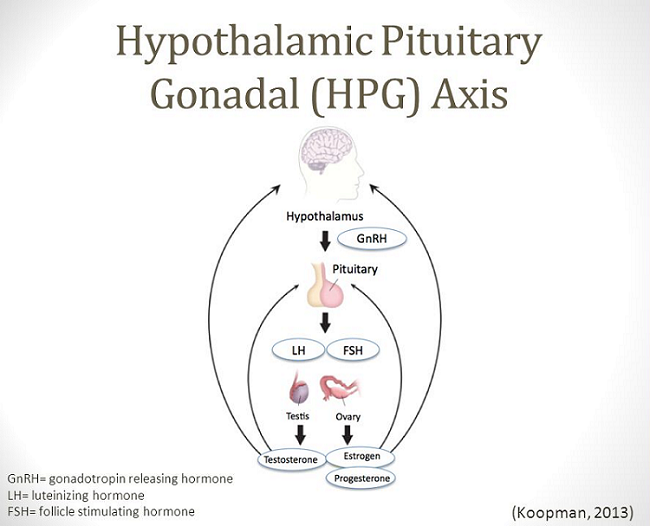Endometriosis and Hormones: Part 1
The Hypothalamic Pituitary Gonadal Axis:
This is a quick 4 minute video I made describing the process in which ovaries are instructed to produce Estrogen and Progesterone. This process provides a better understanding to how GnRH analogue drugs, such as Lupron or Orilissa, stop Estrogen production during use.
The Hypothalamic-Pituitary-Gonadal Axis ( HPA axis).
The hypothalamus is where the naturally occurring Gonadotropin-Releasing Hormone (GnRH) is released in pulses. As it is released, it travels through blood vessels directly to the anterior pituitary gland (via the Hypophyseal Portal System)
The type of pulse indicates whether there will be mostly FSH production or LH production from the ovaries. Low-frequency GnRH pulses are required for FSH release, whereas high-frequency GnRH pulses stimulate LH pulses(1)
“In the female, GnRH pulse characteristics vary depending on the time of the menstrual cycle with more frequent but lower amplitude pulses during the follicular phase. High-frequency pulses of approximately every 60–90 min favor LH secretion in the follicular phase, while low-frequency pulses of every 200 min favor FSH secretion in the late luteal phase.” (2)
Note that the pituitary gland has two parts – the anterior and posterior components. They each serve independent purposes, and this GnRH process only occurs at the anterior portion.
The cells of the anterior pituitary gland, gonadotrophs, have specific receptors for GnRH, which finds Its receptor and binds in a precise way. FSH and LH travel through the blood after leaving the anterior pituitary gland to the ovaries. There are two different types of cells to focus on: on theca and the granulosa cells. LH will act on the theca cells to produce testosterone. FSH acts on the granulosa cells to produce estrogen and progesterone. Granulose cells also release inhibin. As its name suggests, it inhibits the release of FSH from the pituitary gland. When there is sufficient estrogen, progesterone, and testosterone, inhibin tells the pituitary gland that FSH and LH are not needed.
Remember, the pulses are extremely important.
1. Plant, Tony M. “60 YEARS OF NEUROENDOCRINOLOGY: The hypothalamo-pituitary-gonadal axis.” The Journal of endocrinology vol. 226,2 (2015): T41-54. doi:10.1530/JOE-15-0113
2. Ehlers, K, Halvorson, L, Glob. Libr. women’s med., (ISSN: 1756-2228) 2013; DOI 10.3843/GLOWM.10285
I am a visual learner – here are some of my favorite resources for better understanding this topic:
Hypothalamic Pituitary Gonadal AXIS

” The hypothalamic-pituitary-gonadal (HPG) axis. During early brain development, gonadotrophin-releasing hormone (GnRH)-releasing neurons (green) migrate from the nasal region to the hypothalamus, where they permanently reside and differentiate. Hypothalamic GnRH neurons secrete GnRH at the median eminence into the hypophyseal portal system and release pulsatile GnRH to the anterior pituitary. GnRH then binds to GnRH receptor 1 on the gonadotrophs to stimulate these cells to produce luteinizing hormone (LH) and follicle-stimulating hormone (FSH), which enter the systemic blood stream through the hypophyseal veins. LH and FSH act on the gonads (Sertoli and Leydig cells in testes and cumulus, mural and thecal cells in ovaries) to induce steroidogenesis and germ cell production which, in turn, maintains sexual competence. The release of kisspeptin from the hypothalamic neurons located in the arcuate (ARC) and anteroventral periventricular nuclei within the preoptic area is critically important for the re-initiation of pulsatile GnRH secretion at puberty. The developmental failure or misregulation of any one or combination of the genes involved in GnRH migration, secretion, and activity at any stage of development may result in congenital hypogonadotropic hypogonadism and Kallmann syndrome. AVPV, anteroventral periventricular nucleus. “
Endocrinol Metab. 2015 Dec;30(4):456-466.
Kim SH. Congenital Hypogonadotropic Hypogonadism and Kallmann Syndrome: Past, Present, and Future. Endocrinol Metab. 2015 Dec;30(4):456-466. https://doi.org/10.3803/EnM.2015.30.4.456
Image By Artoria2e5 (Mingye Wang) – Own work, CC BY 3.0


Anterior Pituitary Roles

(Derr, Rachel & Cameron, Scott & Golden, Sherita. (2006). Pre-Analytic Considerations for the Proper Assessment of Hormones of the Hypothalamic-Pituitary Axis in Epidemiological Research. European journal of epidemiology. 21. 217-26. 10.1007/s10654-006-0011-0. )